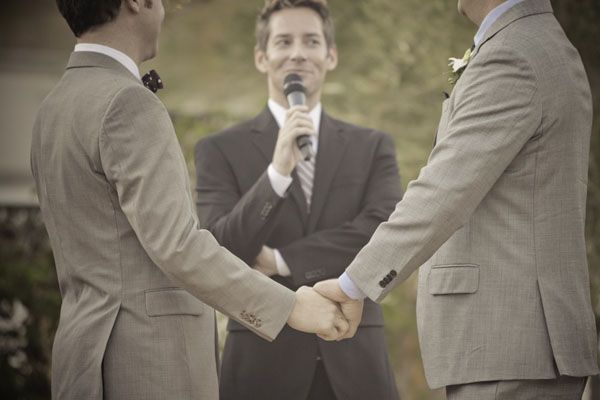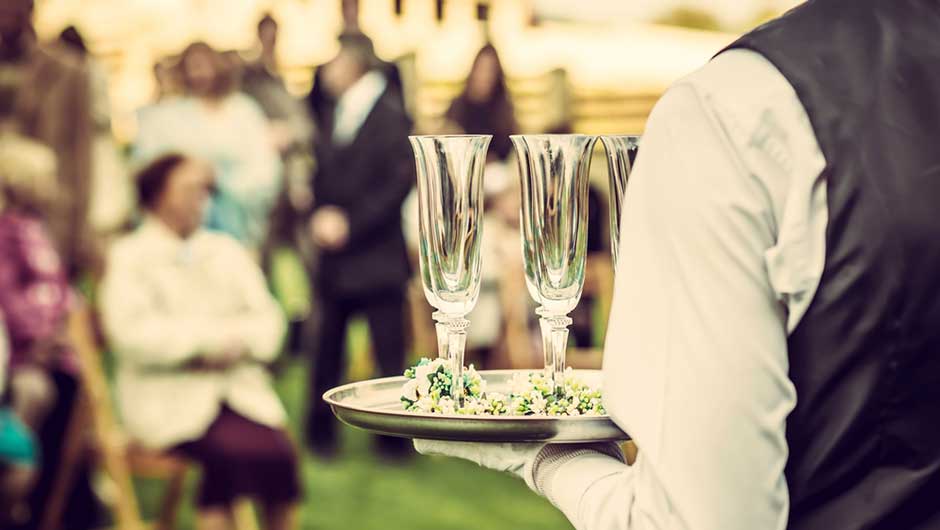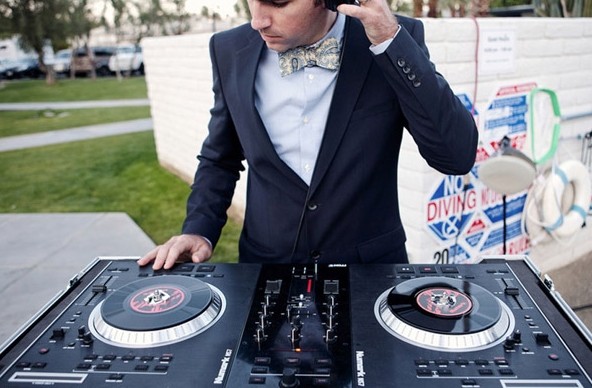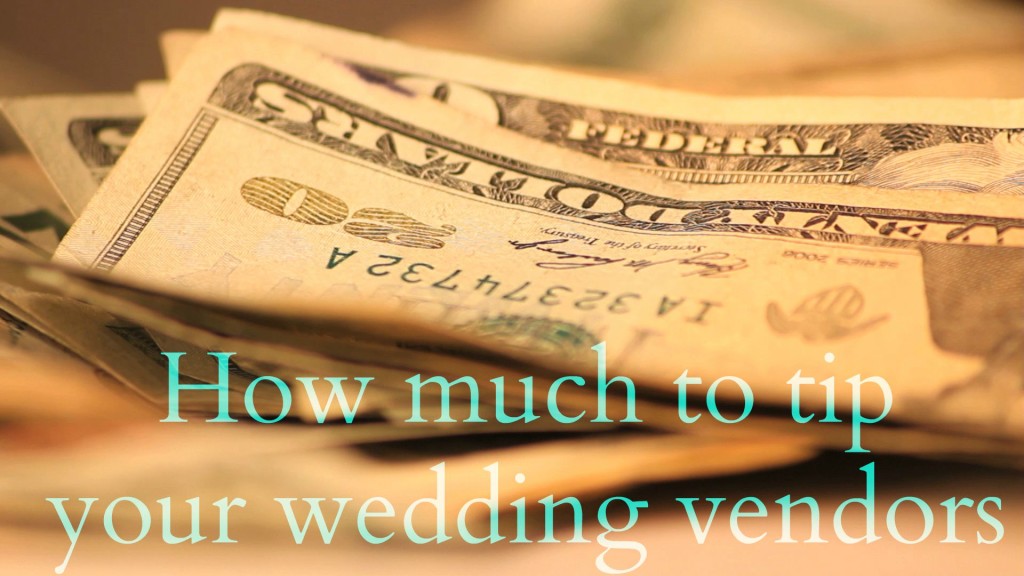Since some vendors will expect a gratuity and other gratuities will need to be considered on a case-by-case scenario, there are a few things to consider.
Traditionally, business owners of larger companies don’t get tipped—just their employees—but you can/should tip an owner when the service exceeds expectations. Small business owners should never be overlooked either, since their businesses are often run by just one person.

Photo: Wedding Bee
Tip vendors who offer exceptional service; thank-you notes are always appreciated; and assign the responsibility to a trusted deputy such as your wedding planner, a parent or the best man. For a breakdown of what’s customary for each vendor, read on.

Wedding Planner
Wedding planners won’t likely expect anything; however, if yours did a great job you can always offer a token of your appreciation. (Note: Non-monetary thank-yous like professional photos of the wedding for the planner’s portfolio can go a long way too.) Approximately 50 percent of couples do tip their planners—typically those with more opulent weddings.
Protocol:
Optional
The $tandard:
Up to $500, or a nice gift
When to Tip:
The bride should hand off the envelope at the end of the reception, or, she should send a thank-you note with photos or a check after the honeymoon.

Photo: sharonreevesevents
Wedding Hair Stylist and Makeup Artist
This is one area where a gratuity is definitely expected. Tip between 15 – 20 percent just as you would in a hair salon, and consider giving a little extra if there’s a crisis, like one of your bridesmaids has a meltdown over her updo and it requires a redo at the last minute.
Protocol:
Expected
The $tandard:
15 – 25 percent, depending upon the quality of service
When to Tip:
At the end of your service

Photo: vimeo
Wedding Delivery and Set-up Staff
Slip a few dollars to anyone delivering important items to the site ( wedding cake , flowers, or sound system). And if a lot of gear needs to be brought in and set up (tents, chairs, or port-a-potties), the workers deserve a tip too.
Protocol:
Expected
The $tandard:
$5 – $10 per person
When to Tip:
Drop off cash envelopes the day before the wedding to the catering manager so the person accepting deliveries can turn the tip.

Photo: Equallywed
Wedding Ceremony Officiant
If your officiant is affiliated with a church or synagogue, you’re often expected to make a donation to that institution. If you’re a member you’ll probably want to give a larger amount than if you’re not. However, if you’re getting married there and they’re charging you to use the space, feel free to give a smaller amount. Tipping the officiant, both nondenominational and denominational, is also appreciated.
Protocol:
Expected (depending on officiant)
The $tandard:
Donate $500+ to the church or synagogue, and for the officiant, an optional tip of $50 – $100
When to Tip:
Most ceremony fees are required prior to the wedding. Otherwise, have the best man pass the cash envelope at the rehearsal dinner if the officiant is in attendance.

Photo: brides.com
Wedding Ceremony Musicians
If you worked with a mini orchestra to come up with the perfect score for your service (and they pulled it off flawlessly), consider showing some monetary thanks for their talent. However, you probably don’t have to tip the solo church organist who was required to play.
Protocol: Optional
The $tandard:
$15 – $20 per musician
When to Tip:
At the end of the ceremony.

Wedding Photographer/Videographer
You’re not expected to give your shutterbugs any dough beyond their normal fees. Yet if the wedding photographer or videographer doesn’t own the studio, consider tipping each person (or give a certain amount with a thank-you note to disperse to staff).
Protocol:
Optional
The $tandard:
$50 – $200 per vendor
When to Tip:
At the end of the reception.

Photo: shefinds
Wedding Reception Staff
This type of staff includes the on-site coordinator, maitre d’, and banquet manager. A service charge (typically 2 percent) is almost always built in to the food and drink fee, so check your contract. If the gratuity is not included, tip as follows.
Protocol:
Expected
The $tandard:
15 – 20 percent of the food and drink fee (based on labor, not the cost), or $200 – $300 for the maitre d’.
When to Tip:
If it’s covered in the contract, the final bill is typically due before the reception. Otherwise, have the father of the bride or best man hand the envelope to the maitre d’ at the end of the reception since you will need to know the final tab to calculate the percentage.

Photo: weddinggirl.com
Wedding Reception Attendants
When it comes to bartenders, waitstaff, parking, bathroom, and coat-room attendants the rules of tipping are dictated by your contract. If the service fee is included, consider doling out extra only if the service was exceptional. If it’s not included, ask ahead of time how many attendants will be working your wedding and calculate on a per person basis.
Protocol:
Optional, based on contract
The $tandard:
$20 – $25 per bartender or waiter; $1 per guest for coat room and parking attendants; $1 per car
When to Tip:
Although tips are traditionally passed out at the end of the event, you could alternately distribute them at the beginning of the evening, to encourage all the workers to give you great service.

Wedding Reception Band or DJ
Whether you hire 12-piece swing band or grooving to a DJ, tipping musicians is completely optional. (Depending on the quality of the job and how willing they were to follow your ideal playlist!) And don’t forget about any sound technicians they bring with them.
Protocol:
Optional, yet preferred
The $tandard:
$20 – $25 per musician; $50 – $150 for DJs
When to Tip:
At the end of the reception, by the best man.

Photo: omahaelegantevents.com
Wedding Transportation
Again, check your contract, as gratuity is usually included. If it isn’t, plan to tip provided they show up on time and don’t get lost!
Protocol:
Expected
The $tandard:
15 – 20 percent of the total bill
When to Tip:
At the end of the night or after the last ride. If you used a separate company for the guest buses, designate a bus captain to hand the driver a tip, otherwise, this duty falls to the best man.



















































